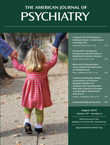Cannabis Use and the Course of Schizophrenia: 10-Year Follow-Up After First Hospitalization
Abstract
Objective
The authors examined the relationship between cannabis use and the course of illness in schizophrenia over 10 years of follow-up after first psychiatric hospitalization.
Method
The authors assessed 229 patients with a schizophrenia spectrum disorder five times: during the first admission and 6 months, 2 years, 4 years, and 10 years later. Ratings of cannabis use and psychiatric symptoms (psychotic, negative, disorganized, and depressive) were made at each assessment.
Results
The lifetime rate of cannabis use was 66.2%, and survival analysis revealed that lifetime use was associated with an earlier onset of psychosis. The rates of current use ranged from 10% to 18% across assessments. Cannabis status was moderately stable, with tetrachoric correlation coefficients between waves ranging from 0.48 to 0.78. Mixed-effects logistic regression revealed that changes in cannabis use were associated with changes in psychotic symptoms over time even after gender, age, socioeconomic status, other drug use, antipsychotic medication use, and other symptoms were controlled for. Structural equation modeling indicated that the association with psychotic symptoms was bidirectional.
Conclusions
Cannabis use is associated with an adverse course of psychotic symptoms in schizophrenia, and vice versa, even after taking into account other clinical, substance use, and demographic variables.



